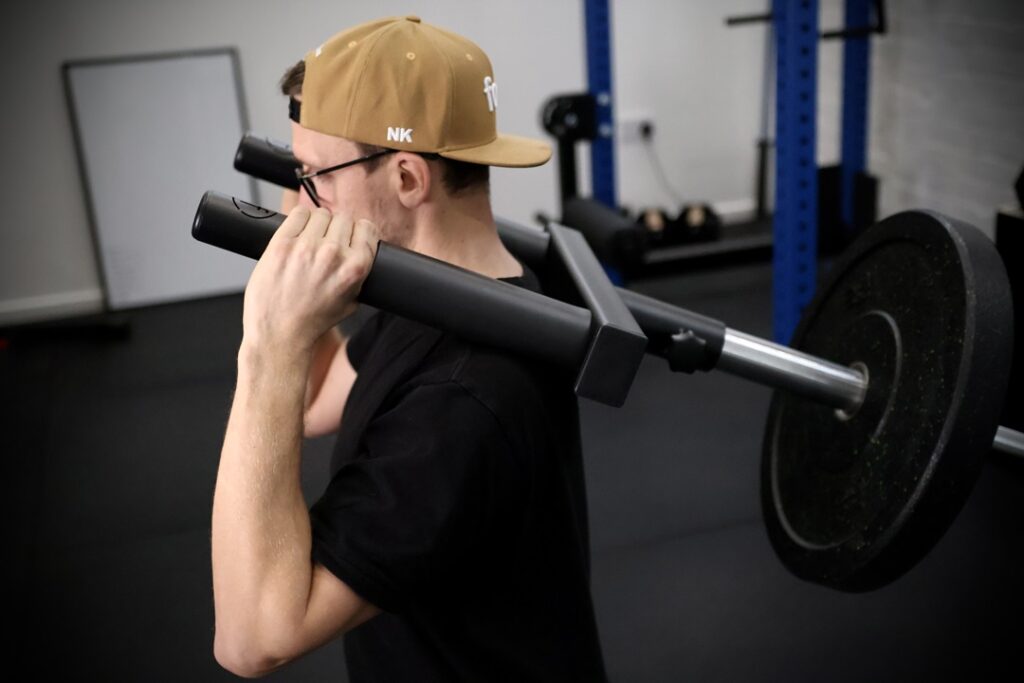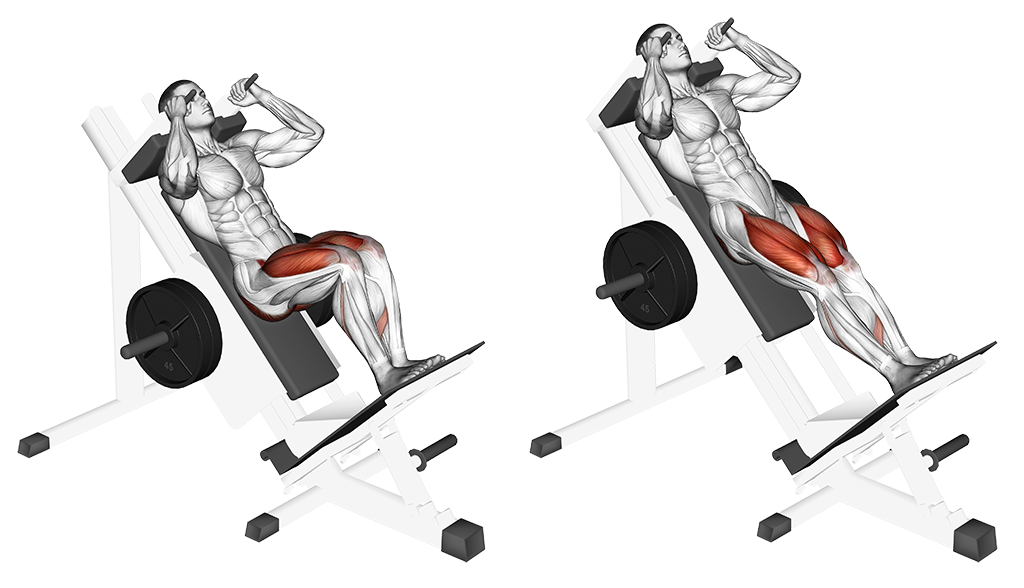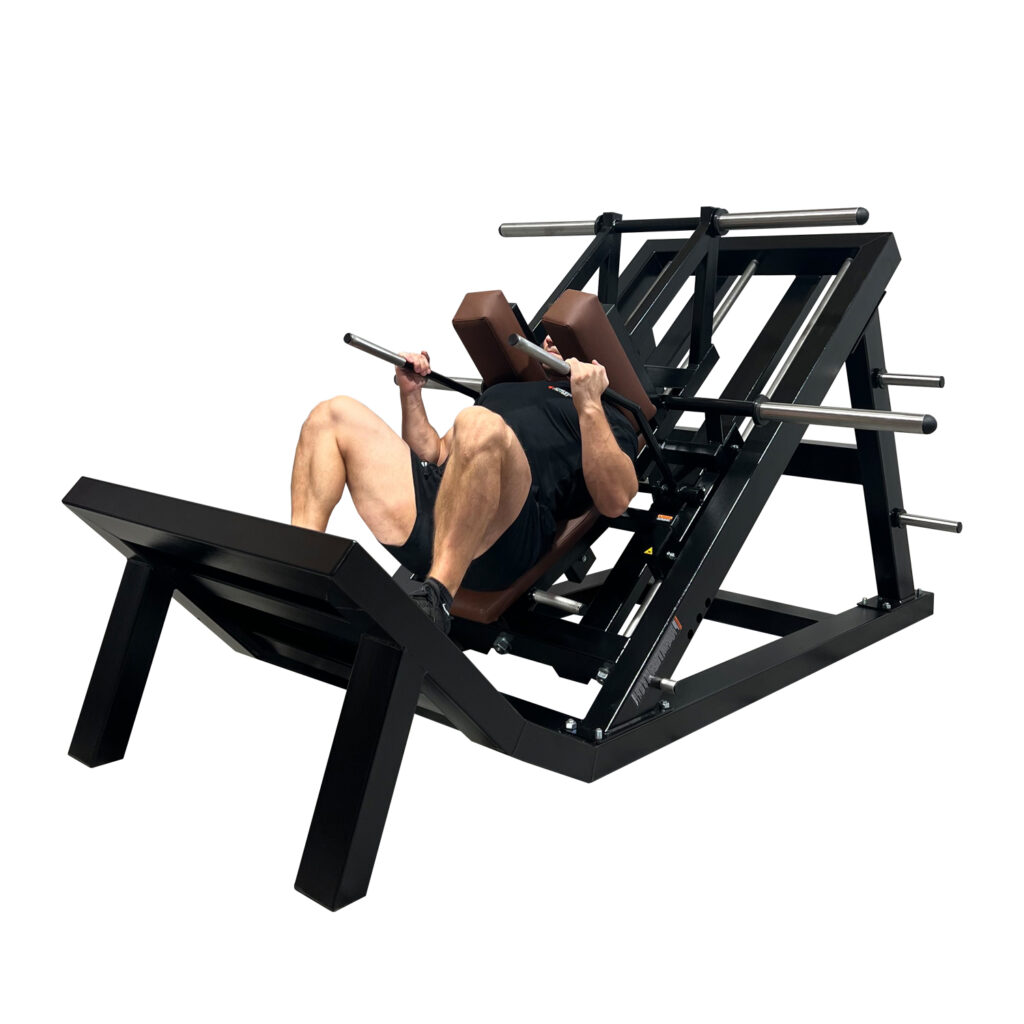The Power of the Hack Squat Attachment

Share This Post
Understanding Hack Squats
Hack squats are a compound exercise that provides a multitude of benefits for those looking to target their lower body muscles. Using the hack squat attachment from Forte Fitness allows individuals to perform this movement with added stability and focus.
Targeted Muscles
The hack squat is specifically designed to build strength and size in the lower body, with a focus on the quadriceps, hamstrings, glutes, and calves. Unlike regular squats which involve stabilising the core to balance the body, hack squats are performed on a machine that supports the back, allowing the lifter to focus more on leg drive and less on core engagement. This makes the exercise especially beneficial for those who want to isolate and develop their lower body muscles without the same degree of core stability required by free weight squats.
Effectiveness Compared to Regular Squats
While hack squats are effective for targeting the lower body, they do not engage the core for balancing as regular squats do. The body is locked into a specific range of motion that may not be ideal for everyone, and if the machine is used incorrectly, there could be potential risks to the lower back, similar to the risks posed by performing regular squats with improper form.
Furthermore, for individuals who may be unable to perform regular squats due to knee issues, range of motion constraints, or shoulder problems, hack squats can serve as an effective substitute. When combined with leg presses, hack squats can contribute to a comprehensive lower body workout routine, helping to build muscle in the legs (Quora).
Despite the differences, both hack squats and regular squats have their place in a balanced fitness regimen. It is often not a matter of one being better than the other, but rather choosing the right variation based on personal goals, physical condition, and preference. For more detailed insights into performing hack squats and incorporating them into your workouts, explore our dedicated sections on hack squat exercises and hack squat alternative.

Benefits and Risks of Hack Squats
Hack. the hack squat attachment is a valuable piece of equipment for targeting specific muscle groups in the lower body. This section will outline the primary muscles engaged during hack squats and discuss potential risks associated with the exercise, along with safety tips to mitigate them.
Muscle Groups Worked
Hack squats are designed to build strength and size in the lower body. The primary muscle groups targeted include the quadriceps, hamstrings, glutes, and calves. Unlike traditional squats, hack squats do not engage the core to the same extent for balancing the body, as the weight travels in a transverse direction and the back is supported by the machine. This allows for a greater focus on the lower body muscles without the added tension on the core.
Here is a breakdown of the muscle groups worked by hack squats:
- Quadriceps: The main focus of the hack squat, which helps in knee extension.
- Hamstrings: Secondary focus, assisting the quads in movement.
- Glutes: Engaged throughout the movement, especially at the bottom of the squat.
- Calves: Stabilisers during the exercise, contracted when pushing up.
For individuals with limitations that prevent them from performing traditional squats, such as knee issues or range of motion constraints, hack squats can serve as an effective alternative along with leg presses to still build lower body strength (Quora).
Potential Risks and Safety Tips
While hack squats can be a beneficial exercise, they carry risks if performed incorrectly, particularly to the lower back. It’s crucial to ensure proper form and not to overload the machine with excessive weight. Hack squats lock the body into a specific range of motion which may not be suitable for every individual and could lead to strain if the form is not adjusted according to one’s body mechanics.
To mitigate these risks, Gear For Fit recommends several safety tips:
- Begin your workout with dynamic stretches and light cardio to warm up the muscles.
- Gradually increase weight over weeks and months instead of making large jumps.
- Prioritise proper form over lifting heavier weights to prevent injury.
- Maintain proper breathing throughout the exercise to support core stability.
- Listen to your body for any signs of pain or discomfort and adjust accordingly.
- Consider having a spotter or trainer present if you are new to the hack squat.
- Perform stretches for the lower body after your workout to aid in recovery.
By adhering to these safety tips and incorporating hack squat exercises into your routine, you can enjoy the benefits of this powerful exercise while minimising the risk of injury. If you’re seeking alternatives to the hack squat, explore our hack squat alternative section for more options.
Proper Technique for Hack Squats
The effectiveness of hack squats using a hack squat attachment largely depends on proper technique. This exercise targets the lower body muscles differently compared to regular squats due to the fixed path of movement and the support provided by the machine.
Body Positioning
To perform a hack squat correctly, the individual must first position themselves on the hack squat machine, ensuring their back is flat against the padded support. Feet should be placed shoulder-width apart on the footplate with toes pointed slightly outward. It is critical to align the knees in the direction of the toes throughout the movement to prevent undue stress on the knee joints.
As the individual lowers into the squat, the hips should move down and back, keeping the chest up and the back neutral. The descent should continue until the thighs are at least parallel to the floor, or slightly lower for a full range of motion.
During the ascent to return to the starting position, the focus should be on driving through the heels and engaging the quadriceps, hamstrings, and glutes to extend the legs. The back should remain in contact with the pad, and the head should be in a neutral position, looking forward.
Breathing and Core Engagement
Even though the hack squat attachment provides ample support, proper breathing and core engagement are crucial for stability and power. Individuals should take a deep breath in as they lower into the squat, engaging the core to maintain torso stability. Exhaling forcefully through the upward phase of the squat can help in engaging the core further and providing the necessary intra-abdominal pressure to support the spine.
It is essential to note that although hack squats do not engage the core for balancing the body like regular squats do, maintaining a braced core will enhance performance and safety during the exercise.
To ensure proper technique and to explore different ways to perform hack squats, including variations and progressions, individuals can refer to the range of hack squat exercises available. Additionally, for those seeking alternatives that do not require a machine, a variety of hack squat alternative exercises can be integrated into their workout routines.

Incorporating Hack Squats in Workouts
Hack squats, performed using a hack squat attachment, are a powerful exercise for those looking to enhance leg strength and muscle definition. The exercise primarily targets the quadriceps, but also engages the glutes, hamstrings, and calves, making it a comprehensive lower-body workout.
Leg Day Routine
When planning a leg day routine, it’s crucial to include exercises that target different muscle groups for balanced development. Hack squats can be a central part of this routine due to their effectiveness in building leg strength. A sample leg day routine incorporating hack squats might look like this:
| Exercise | Sets | Repetitions |
|---|---|---|
| Hack Squats | 3-4 | 8-12 |
| Leg Press | 3-4 | 10-15 |
| Deadlifts | 3 | 6-10 |
| Leg Curls | 3-4 | 10-15 |
| Calf Raises | 4 | 12-15 |
Start the session with hack squats to take advantage of your energy levels when they’re at their peak. Follow with other compound movements like leg presses and deadlifts, and finish with isolation exercises such as leg curls and calf raises. This approach ensures that you’re hitting all the major muscle groups in the lower body.
Variations and Progressions
The hack squat itself can be varied to target different aspects of the lower body muscle groups. Some common variations include changing foot placement (wider or narrower) or altering the depth of the squat. As individuals become more comfortable with the hack squat movement, they can progress to more challenging variations, such as the traditional barbell squat (Healthline).
For those seeking to increase the intensity of their hack squats, the following progressions can be considered:
- Increasing the weight on the hack squat machine
- Incorporating pause reps, where you hold the squat position for a count before rising
- Adding single-leg hack squats to challenge stability and unilateral strength
It’s important to progress gradually to prevent injury and to ensure consistent improvement in strength and muscle development. Always prioritise proper form and technique over lifting heavier weights, especially when trying new variations.
For individuals who may not have access to a hack squat machine or are looking for an alternative, there are free-weight exercises that can serve as a hack squat alternative. Exercises such as goblet squats or front squats can offer similar benefits and are worth exploring as part of a comprehensive leg training program.
Incorporating hack squats into your workouts, whether as part of a structured leg day routine or within a broader fitness program, can significantly improve lower body strength and aesthetics. As with any resistance exercise, it’s essential to combine these workouts with proper nutrition and recovery strategies to maximise the benefits and achieve the best possible results.
Hack Squat Machine Considerations
When incorporating the hack squat machine into your fitness regime, it’s important to understand how to set up and use the machine correctly to ensure safety and maximise the effectiveness of your workouts. Here we will discuss the correct machine setup and how to adjust the weight and intensity to tailor your hack squat sessions.
Machine Setup
The initial setup of the hack squat machine is crucial for a safe and effective workout. Begin by adjusting the machine to fit your body size and shape. This may involve setting the height of the shoulder pads and the angle of the backrest to ensure comfort and proper alignment.
It’s also important to position your feet correctly on the platform. The feet should be shoulder-width apart, with the toes slightly pointed outwards. This stance will provide stability and allow for a full range of motion during the squat.
| Step | Action |
|---|---|
| 1 | Adjust shoulder pads to match shoulder height |
| 2 | Set backrest angle to comfortably align with your back |
| 3 | Place feet shoulder-width on the platform with toes out |
For more detailed guidance on setting up your hack squat equipment and how to use it, you can refer to manufacturers’ manuals or seek advice from a fitness professional.
Adjusting Weight and Intensity
Adjusting the weight and intensity of your hack squats is crucial for progressive strength development and avoiding injury. Start with a weight that allows you to perform the exercise with proper form while feeling challenged.
As you become more experienced with the hack squat, you can gradually increase the weight you use. However, it’s essential to listen to your body and not overload the machine with excessive weight, which can lead to improper form and potential injury (Gear For Fit).
If you experience back pain during hack squats, it’s recommended to adjust the weight, sets, or frequency rather than stopping the exercise altogether. This can help alleviate discomfort while still strengthening the lower back and supporting muscles.
| Consideration | Recommendation |
|---|---|
| Starting Weight | Choose a weight that allows for correct form |
| Progression | Increase weight gradually over weeks or months |
| Pain Management | Adjust weight and frequency if experiencing discomfort |
By paying attention to these considerations, you can safely incorporate hack squat exercises into your routine, ensuring that you are effectively targeting the desired muscle groups while minimising the risk of injury. Remember to also consider hack squat alternatives if you’re looking for variety in your leg day workouts.

Hack Squats vs. Regular Squats
When considering the best exercises for leg development, both hack squats and regular squats come to mind. Each has its own set of benefits, targeting different muscle groups and offering varied workout experiences.
Key Differences
One of the primary distinctions between hack squats and regular squats is the muscle focus. Hack squats primarily target the quadriceps and glutes but remove the core’s role in balancing the body, as the weight travels in a controlled, fixed path. This is due to the back being supported by the machine, which eliminates tension from the core muscles.
On the other hand, regular squats are a more full-body movement, involving not just the legs but also engaging the core, back, and shoulders to stabilise the body. This engagement makes regular squats a compound exercise, working multiple muscle groups simultaneously.
| Squat Variation | Target Muscles | Core Engagement | Equipment Needed |
|---|---|---|---|
| Hack Squat | Quads, Glutes | Minimal | Hack Squat Machine |
| Regular Squat | Quads, Glutes, Core, Back, Shoulders | High | Barbell, Weights |
Furthermore, the range of motion differs between the two. Regular squats allow for a natural movement pattern, which can be more suitable for various body types, whereas hack squats lock the body into a specific trajectory. This fixed path might not be ideal for everyone and could pose risks to the lower back if done incorrectly, similar to the risks associated with poorly executed regular squats.
Choosing the Right Variation
Selecting between hack squats and regular squats depends on individual goals, fitness levels, and preferences. For those new to squatting, the hack squat attachment can provide a supportive way to build strength in the legs with less concern for upper body stability and balance (Healthline). It’s a great addition to a leg day routine, but it should not be the sole focus; incorporating other squat variations is beneficial for overall development.
For those aiming to improve full-body strength and coordination, regular squats using a barbell might be the better choice. Regular squats offer versatility and can be adjusted to suit a wide range of fitness levels and body types. As one becomes more comfortable with squatting, they may progress from the hack squat to the traditional barbell squat (Healthline).
Incorporating both hack squats and regular squats into a workout regimen can yield comprehensive strength gains. Hack squats can provide focused leg work, while regular squats engage the entire body. For those with lower back concerns, the hack squat machine supports the back and can be adjusted in weight and intensity to accommodate individual needs.
When deciding which squat variation to include in your routine, consider your fitness objectives, any physical limitations, and how each exercise complements your overall training program. For more information on how to perform hack squats safely and effectively, explore our collection of hack squat exercises and consider hack squat alternatives that can provide similar benefits with different equipment or movements.

More To Explore
The Ultimate Guide to Skipping: Unlocking Strength, Balance, and Stress Relief with a flow rope
Flow rope training is a dynamic workout method that involves using a thick braided rope to create rhythmic, fluid movements. Unlike traditional jump rope exercises, a flow rope workout doesn’t necessarily require jumping. Instead, you move with the rope rather than against it, making it an excellent workout for balance, coordination, and relaxation. Popular among
The Benefits of Training with a Weighted Vest: Boost Your Strength and Endurance
Integrating a weighted vest into workout routines is an increasingly popular fitness strategy aimed at enhancing the effectiveness of various exercises. This comprehensive guide examines how weighted vests can significantly boost physical fitness by increasing the intensity of workouts, details the potential risks, and offers insights into maximising benefits while minimising potential drawbacks. What is